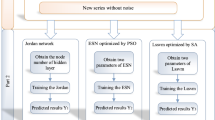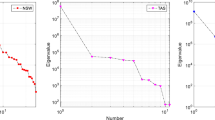Abstract
The stable operation of power system has the strong constraint of load balance. Accurate power load forecasting is of great significance in ensuring power system planning and reliable and economic operation. For this purpose, a novel power load forecasting integrating variational modal decomposition (VMD), t-distributed stochastic neighbor embedding dimension reduction visualization analysis (t-SNE), compound prediction models adopting least squares support vector machine (LSSVM) and Tent mapping function as well as chaotic sparrow search algorithm (CSSA), is proposed in this paper. To begin with, for the high-dimensional meteorological data affecting the power load forecasting, the t-SNE is adopted. Meanwhile, the comparison experiments with five common dimensional reduction algorithms prove that t-SNE can better map high-dimensional meteorological data to low-dimensional space. Then, the VMD is used to decompose the electricity load, which decomposes the non-stationary electricity load series into multiple sets of relatively stationary sub-series. Meanwhile, key parameters in the LSSVM model are optimized using the CSSA optimization algorithm under Tent chaotic perturbation, and the component is predicted by optimized LSSVM model. Finally, the ultimate forecasting results of the electricity load are calculated by superimposing the predicted values of all components. The experiments results reveal that the proposed model provides competitive advantages over other models and offers greater prediction accuracy.













Similar content being viewed by others
References
Li C (2020) Designing a short-term load forecasting model in the urban smart grid system. Appl Energy 266:114850. https://doi.org/10.1016/j.apenergy.2020.114850
Salkuti SR (2018) Short-term electrical load forecasting using radial basis function neural networks considering weather factors. Electr Eng 100(3):1985–1995. https://doi.org/10.1007/s00202-018-0678-8
Roweis ST, Saul LK (2000) Nonlinear dimensionality reduction by locally linear embedding. Science 290(5500):2323–2326. https://doi.org/10.1126/science.290.5500.2323
Bao GQ, Lin QL, Gong DW, et al (2016) Hybrid short-term load forecasting using principal component analysis and MEA-Elman network[C]//International conference on intelligent computing. Springer International Publishing 9773: 671–683. https://doi.org/10.1007/978-3-319-42297-8_62
Anowar F, Sadaoui S, Selim B (2021) Conceptual and empirical comparison of dimensionality reduction algorithms (PCA, KPCA, LDA, MDS, SVD, LLE, ISOMAP, LE, ICA, t-SNE). Comput Sci Rev 40:100378. https://doi.org/10.1016/j.cosrev.2021.100378
Bunte K, Haase S, Biehl M et al (2012) Stochastic neighbor embedding (SNE) for dimension reduction and visualization using arbitrary divergences. Neurocomputing 90:23–45. https://doi.org/10.1016/j.neucom.2012.02.034
Zhu WB, Webb ZT, Mao K et al (2019) A deep learning approach for process data visualization using t-distributed stochastic neighbor embedding. Ind Eng Chem Res 58(22):9564–9575. https://doi.org/10.1021/acs.iecr.9b00975
Zhang Q, Zhang JJ (2020) Short-term load forecasting method based on EWT and IDBSCAN. J Electr Eng Technol 15:635–644. https://doi.org/10.1007/s42835-020-00358-0
Santhosh M, Venkaiah C, Kumar DMV (2018) Ensemble empirical mode decomposition based adaptive wavelet neural network method for wind speed prediction. Energy Convers Manag 168:482–493. https://doi.org/10.1016/j.enconman.2018.04.099
Bedi J, Toshniwal D (2018) Empirical mode decomposition based deep learning for electricity demand forecasting. IEEE Access 6:49144–49156. https://doi.org/10.1109/ACCESS.2018.2867681
He FF, Zhou JZ, Mo L et al (2020) Day-ahead short-term load probability density forecasting method with a decomposition-based quantile regression forest. Appl Energy 262:114396. https://doi.org/10.1016/j.apenergy.2019.114396
Yu CJ, Li YL, Zhang MJ (2017) An improved wavelet transform using singular spectrum analysis for wind speed forecasting based on Elman neural network. Energy Convers Manag 148:895–904. https://doi.org/10.1016/j.enconman.2017.05.063
He FF, Zhou JZ, Feng ZK et al (2019) A hybrid short-term load forecasting model based on variational mode decomposition and long short-term memory networks considering relevant factors with Bayesian optimization algorithm. Appl Energy 237:103–116. https://doi.org/10.1016/j.apenergy.2019.01.055
Zhang YG, Chen B, Pan GF et al (2019) A novel hybrid model based on VMD-WT and PCA-BP-RBF neural network for short-term wind speed forecasting. Energy Convers Manag 195:180–197. https://doi.org/10.1016/j.enconman.2019.05.005
Mi XW, Liu H, Li YF (2019) Wind speed prediction model using singular spectrum analysis, empirical mode decomposition and convolutional support vector machine. Energy Convers Manag 180:196–205. https://doi.org/10.1016/j.enconman.2018.11.006
Lee D, Park Y-G, Park J-B et al (2017) Very short-term wind power ensemble forecasting without numerical weather prediction through the predictor design. J Electr Eng Technol 12(6):2177–2186. https://doi.org/10.5370/JEET.2017.12.6.2177
Santos DO, Júnior DS, De Oliveira JFL, De Mattos Neto PSG (2019) An intelligent hybridization of ARIMA with machine learning models for time series forecasting. Knowl-Based Syst 175:72–86. https://doi.org/10.1016/j.knosys.2019.03.011
Shikhah NA, Elkarmi F, Aloquili OM (2011) Medium-term electric load forecasting using multivariable linear and non-linear regression. Smart Grid Renew Energy 2(2):126–135. https://doi.org/10.4236/sgre.2011.22015
Khwaja AS, Zhang X, Anpalagan A et al (2017) Boosted neural networks for improved short-term electric load forecasting. Electr Power Syst Res 143:431–437. https://doi.org/10.1016/j.epsr.2016.10.067
Ke K, Sun HB, Zhang CK et al (2019) Short-term electrical load forecasting method based on stacked auto-encoding and GRU neural network. Evol Intel 12:385–394. https://doi.org/10.1007/s12065-018-00196-0
Kwon BS, Park RJ, Song KB (2020) Short-term load forecasting based on deep neural networks using LSTM layer. J Electr Eng Technol 15:1501–1509. https://doi.org/10.1007/s42835-020-00424-7
Chen ZX, Zhang DL, Jiang HR et al (2021) Load forecasting based on LSTM neural network and applicable to loads of “replacement of coal with electricity.” J Electr Eng Technol 16:2333–2342. https://doi.org/10.1007/s42835-021-00768-8
Luo RX, Liu SM, You MN et al (2021) Load forecasting based on weighted grey relational degree and improved ABC-SVM. J Electr Eng Technol 16:2191–2200. https://doi.org/10.1007/s42835-021-00727-3
Moradzadeh A, Zakeri S, Shoaran M et al (2020) Short-term load forecasting of microgrid via hybrid support vector regression and long short-term memory algorithms. Sustainability 12(17):7076. https://doi.org/10.3390/su12177076
Yang AL, Li WD, Yang X (2019) Short-term electricity load forecasting based on feature selection and least squares support vector machines. Knowl-Based Syst 163:159–173. https://doi.org/10.1016/j.knosys.2018.08.027
Raza MQ, Nadarajah M, Hung DQ et al (2017) An intelligent hybrid short-term load forecasting model for smart power grids. Sustain Cities Soc 31:264–275. https://doi.org/10.1016/j.scs.2016.12.006
Liang Y, Niu DX, Hong WC (2019) Short term load forecasting based on feature extraction and improved general regression neural network model. Energy 166:653–663. https://doi.org/10.1016/j.energy.2018.10.119
Xue JK, Shen B (2020) A novel swarm intelligence optimization approach: sparrow search algorithm. Syst Sci Control Eng 8(1):22–34. https://doi.org/10.1080/21642583.2019.1708830
Zhang CL, Ding SF (2021) A stochastic configuration network based on chaotic sparrow search algorithm. Knowl-Based Syst 220:106924. https://doi.org/10.1016/j.knosys.2021.106924
Deng W, Yao R, Zhao HM et al (2019) A novel intelligent diagnosis method using optimal LSSVM with improved PSO algorithm. Soft Comput 23:2445–2462. https://doi.org/10.1007/s00500-017-2940-9
Barman M, Choudhury DNB, Sutradhar S (2018) A regional hybrid GOA-SVM model based on similar day approach for short-term load forecasting in Assam, India. Energy 145:710–720. https://doi.org/10.1016/j.energy.2017.12.156
Hu YS, Li JG, Hong MN et al (2019) Short-term electric load forecasting model and its verification for process industrial enterprises based on hybrid GA-PSO-BPNN algorithm-A case study of papermaking process. Energy 170:1215–1227. https://doi.org/10.1016/j.energy.2018.12.208
Zhou JG, Chen DF (2021) Carbon price forecasting based on improved CEEMDAN and extreme learning machine optimized by sparrow search algorithm. Sustainability 13(9):4896. https://doi.org/10.3390/su13094896
Zhang ZC, Ding SF, Sun YT (2020) A support vector regression model hybridized with chaotic krill herd algorithm and empirical mode decomposition for regression task. Neurocomputing 410:185–201. https://doi.org/10.1016/j.neucom.2020.05.075
Funding
National Natural Science Foundation of China, 51907104
Author information
Authors and Affiliations
Corresponding author
Ethics declarations
Conflict of interest
The authors have no financial or proprietary interests in any material discussed in this article.
Additional information
Publisher's Note
Springer Nature remains neutral with regard to jurisdictional claims in published maps and institutional affiliations.
Rights and permissions
About this article
Cite this article
Wang, L., Tian, T., Xu, H. et al. Short-Term Power Load Forecasting Model Based on t-SNE Dimension Reduction Visualization Analysis, VMD and LSSVM Improved with Chaotic Sparrow Search Algorithm Optimization. J. Electr. Eng. Technol. 17, 2675–2691 (2022). https://doi.org/10.1007/s42835-022-01101-7
Received:
Revised:
Accepted:
Published:
Issue Date:
DOI: https://doi.org/10.1007/s42835-022-01101-7




